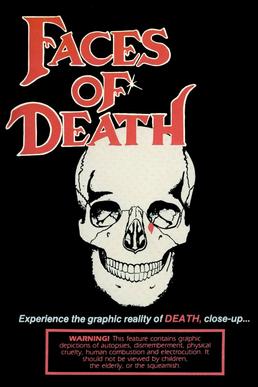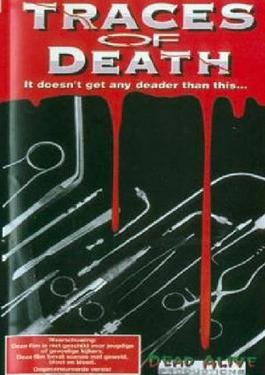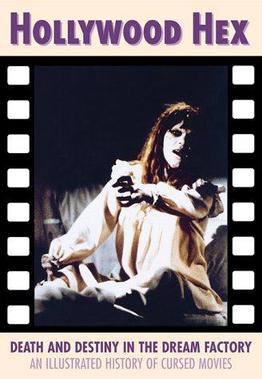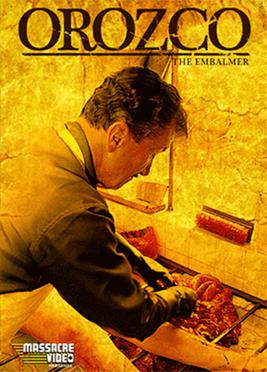A snuff film, snuff movie or snuff video is a theoretical type of film, produced for profit or financial gain, that shows, or purports to show, scenes of actual homicide. The victims are supposedly typically lured to their murders by false pretenses and their murder is then filmed and the video depicting it is sold to buyers.

Snuff is a 1976 splatter film directed by Michael Findlay and Horacio Fredriksson. Originally an exploitation film loosely based on the 1969 murders committed by the Manson Family, it is most notorious for being falsely marketed as if it were an actual snuff film. The controversy about the film was deliberately manufactured to attract publicity: it prompted an investigation by the New York County District Attorney, who determined that the murder shown in the film was fake. This picture contributed to the urban legend of snuff films, although the concept did not originate with it.

Peeping Tom is a 1960 British psychological horror-thriller film directed by Michael Powell, written by Leo Marks, and starring Carl Boehm, Anna Massey, and Moira Shearer. The film revolves around a serial killer who murders women while using a portable film camera to record their dying expressions of terror, putting his footage together into a snuff film used for his own self pleasure. Its title derives from the expression "peeping Tom", which describes a voyeur.

Faces of Death is a 1978 American mondo horror film written and directed by John Alan Schwartz, credited under the pseudonyms "Conan Le Cilaire" and "Alan Black" respectively.
Mondo film is a subgenre of exploitive documentary films. Many mondo films are made in a way to resemble a pseudo-documentary and usually depicting sensational topics, scenes, or situations. Common traits of mondo films include portrayals of foreign cultures, an emphasis on taboo subjects such as death and sex, and staged sequences presented as genuine documentary footage. Over time, the films have placed increasing emphasis on footage of the dead and dying.

Traces of Death is a 1993 American mondo film that consists of various scenes of stock footage depicting death and real scenes of violence.
Michael Findlay was an American filmmaker, producer and screenwriter. Along with his wife Roberta, Findlay created numerous low-budget Z movies in the 1960s and 1970s. They have been described as "the most notorious filmmakers in the annals of sexploitation".

Black Emanuelle is a softcore sexploitation film from 1975 directed by Bitto Albertini. The film was set in Africa and shot mostly in Kenya. The music was composed by Nico Fidenco. Black Emanuelle was followed by a number of sequels, all revolving around the erotic adventures of Mae Jordan, a globe-trotting, hedonistic investigative journalist and photographer known to her readers as "Emanuelle". Her character has been described as "a strong and independent woman, sexually proactive, at the centre of wealthy young and old white men of power, and involved in any sort of depraved set and situation."

Ultime grida dalla savana, also known as by its English title Savage Man Savage Beast, is a 1975 Italian mondo documentary film co-produced, co-written, co-edited and co-directed by Antonio Climati and Mario Morra. Filmed all around the world, its central theme focuses on hunting and the interaction between man and animal. Like many mondo films, the filmmakers claim to document real, bizarre and violent behavior and customs, although some scenes were actually staged. It is narrated by the Italian actor and popular dubber Giuseppe Rinaldi and the text was written by Italian novelist Alberto Moravia.

Last House on Dead End Street, originally released as The Fun House, is a 1977 American exploitation horror film written, produced, and directed by Roger Watkins, under the pseudonym Victor Janos. The plot follows a disgruntled ex-convict who takes revenge on society by kidnapping four acquaintances and filming their murders in an abandoned building.

Hollywood Hex is a book by Mikita Brottman, an in-depth history of movies plagued with bad luck or perceived as cursed. The book deals with deaths on-set, copycat crimes, obsessed fans, bizarre coincidences, and other incidents which lead a film to be called "cursed".

Meat Is Murder: An Illustrated Guide to Cannibal Culture is a book originally published in 1998, which examines cannibalism in myth, true crime, and film.

Emanuelle's Revenge is an Italian film directed by Joe D'Amato. It is a remake of the Greek film The Wild Pussycat (1969). Unlike the French Emmanuelle series, to which it refers only in name, Emanuelle's Revenge has been described as being close to a sex-themed giallo, or as a combination of several genres: the rape and revenge film, the splatter film, the erotic film and the thriller. The film was written by Bruno Mattei and D'Amato. Bruno Mattei co-directed the film with D'Amato, but only D'Amato was credited.
Maritza Martin Munoz was an American woman shot to death by her ex-husband, Emilio Nuñez, at Our Lady Queen of Heaven Cemetery in North Lauderdale, Florida. Nuñez had been interviewed by Ocurrió Así television reporter Ingrid Cruz, who accompanied him when he visited his daughter's grave. While the crew was filming Nuñez at the cemetery, Martin arrived for her own visit, at which time Cruz confronted Martin, who was sitting silently in her vehicle, insisting that Martin answer her questions. Martin and Nuñez' 15-year-old daughter, Yoandra, had killed herself in November 1992 following their discovery of her being 13 weeks pregnant, and Nuñez had blamed the incident on Martin. Nuñez believed that their daughter had been abused by her stepfather and murdered or driven to suicide by her mother. Both theories were rejected by investigators. Yoandra had been raised by Martin; Nuñez was prevented from contact with her.

Dolce e selvaggio is a 1983 Italian mondo film directed by Antonio Climati and Mario Morra. The title "Sweet and Savage" refers to the juxtaposition of pleasant 'sweet' and violent 'savage' imagery within the film. It is narrated by the producer and long-time Mondo film director Franco Prosperi.

Mondo Cane is a 1962 Italian mondo documentary film and directed by the trio of Gualtiero Jacopetti, Paolo Cavara, and Franco E. Prosperi, with narration by Stefano Sibaldi. The film consists of a series of travelogue scenes that provide glimpses into cultural practices around the world with the intention to shock or surprise Western film audiences. These scenes are presented with little continuity, as they are intended as a kaleidoscopic display of shocking content rather than presenting a structured argument. Despite its claims of genuine documentation, certain scenes are either staged or creatively manipulated to enhance this effect.

Black Emanuelle 2, is a 1976 Italian psychological drama-sexploitation film directed by Bitto Albertini. It is an unofficial sequel of Black Emanuelle.

Women of the World is a 1963 Italian mondo film, also described as a "shockumentary", written and directed by filmmakers Gualtiero Jacopetti, Paolo Cavara, and Franco Prosperi. It was rushed into release on 30 January, following the international box-office success achieved by its predecessor, the initial mondo film, Mondo Cane, which premiered in Italy ten months earlier, 30 March 1962. The English language print was narrated by Peter Ustinov.

Orozco the Embalmer is a 2001 Spanish-language Japanese-Colombian mondo film directed by Kiyotaka Tsurisaki. It follows a Colombian embalmer named Froilan Orozco Duarte, who is shown living in El Cartucho, an impoverished and crime-ridden area of Bogotá, Colombia, where the homicide rate is high and corpses can be seen on the streets.
Simon Nuchtern is a Belgian-born American filmmaker who is based in New York. He has directed, written, and produced a number of low-budget and independent films since the 1960s.















